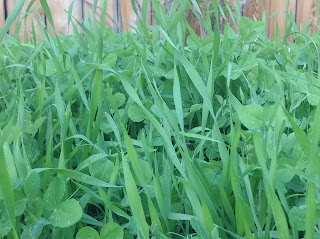 |
| June 7.5 inches |
Rain
Colorado averages between fourteen and fifteen inches of precipitation a year. Putting that in how little that amount is perspective, Massachusetts receives forty-seven. The weather service measures moisture amounts at Denver International Airport, the totals in my yard are usually higher. In 2015, Denver received 18.22 total inches of precipitation, that's through 12/27. The "head scratching, can't believe this is happening rain months" were May and June.
In May we received a little over five inches and in June close to seven and a half. The math is easy, we received a boatload of precip. in the prime time spring planting window. As a result my tomatoes went in the ground around July 4th about the same time I harvested garlic. On the flip side, the cool-season vegetables were in heaven with the lower temperatures and wet weather - broccoli, lettuce, spinach, potatoes and kale sailed through to the dinner plate deliciously fine.
And wouldn't you know, the faucet quit flowing in August and most of the fall season. At least it wasn't a repeat of November 2014's freeze event, so plants benefited from the normal gradual hardening off period. By the way, my plant losses weren't too bad from the '14 flash freeze, mostly newly planted perennials and two Rose of Sharon trees that I'm still watching for recovery.
Fall was simply spectacular. Not only did roses rally for another bloom cycle (they really missed the spring season), but late summer thrillers performed on cue. Coneflowers, penstemons, monarda, echinops, lavender, and asters....the list is too long to mention all of them. Trees enjoyed a long period to show off their fall glory before we all turned our thoughts to what side dishes to prepare for Thanksgiving.
And now we're in the chill of late December and looking forward to what She'll throw at us next. We know for sure that the days are lengthening and the trowel beckons.
Japanese Beetles
Oh...those darn Japanese beetles. I will not swear in my writing, but curse words are spot on to describe their presence in one's yard. The first JB I spotted was on a patio container 'Rosa Bianca' eggplant in late June. Then they gathered to stay, play and eat on the fence of silver lace vines, which are the collective veil of privacy from the alley to our backyard. They had to go! I tried the easy way first - flicking them in to a soapy jar of water, but the numbers were too great and I couldn't easily reach them on top of the vines. I mixed up some organic BioNEEM® which mildly discouraged them. Then I cried and commiserated with other area gardeners who were battling them as much or more than me. Then we all cried as the heat of August kicked in when their eating and mating season moved into fifth gear....turbo gear! I learned about a biological (organic) product that works on both adult beetles and their larvae. It contains the active ingredient Btg. It was only available from one mail order supply company. I'm hoping it has a wider distribution next summer. I wrote several blogs about Japanese beetles and control options (including Btg) and protocols a few months ago. More - Japanese beetles
 |
| Japanese Beetles on Roses |
At the end of each garden year there isn't a downside, at least in my book. What happened happened. The tomatoes finally ripened and we enjoyed several warm fall evenings on the patio. Gardeners will collectively hit the ground running with new hope and vigor in a few months. In the meantime I'll read up on the latest plant introductions while Adele is playing in the background.
Happy New Year!
Thank You for Reading My Blog and Denver Post Punch Lists!



















